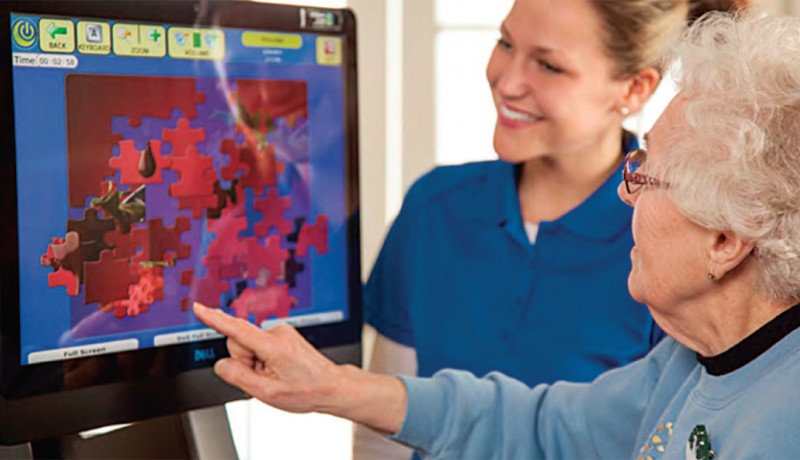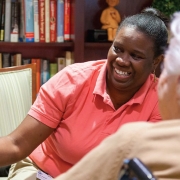
Columns

International columnist Jack York on the endless possibilities of using technology in engaging older adults living with dementia
I’m taking a twist on this month’s piece for Harmony… all the topics I’ve covered in my columns have been about giving an Indian twist to what we see technology-wise in the ageing population in the US. My next piece will get back into that groove—I already have a couple of stories lined up—but I wanted to take a break from that to report on what we see happening in the US regarding technology, and specifically how it relates to older adults living with dementia.
Our company iN2L was not originally envisioned as a business. Instead, it grew out of a philanthropic idea to donate computers to assisted living communities and nursing centres in Southern California. With my 15-year background in Silicon Valley, I saw a vast potential in fostering these connections, but also realised that conventional technology was difficult for older adults to use in meaningful ways. So, in 1999, I retired as vice-president of strategic sales for Vishay Intertechnology and started a ‘gerontechnology’ company. Today, we have a customer base of over 2,500 senior living communities spread across the US and Canada.
Though it was never our original intention, iN2L now works to ensure that technology to engage older adults includes people living with dementia. It’s fascinating to see the outcomes, and the possibilities. And it’s often not that complicated. A lot of our work has been around looking at ways to take the tools that we take for granted today—such as Google Earth, Skype, flight simulators—and look at ways to make them easily accessible through our interface and ease-of-use accessibility tools. Every person is unique; our success has been driven by providing technology that can reach everyone! Each resident can have an individual profile and unique set of content on our systems. It doesn’t matter whether they are from Ohio or Hyderabad!
Huge gaps and opportunities exist in the technology and ageing space. Most technology development and stories are about ageing-in-place, and keeping older adults as independent and healthy for as long as possible. Forward-thinking communities in the US are stepping up the realisation that many of their more independent residents are moving into their communities with a working knowledge of apps and connectivity, smartphones in hand. Unfortunately, people dealing with cognitive decline, in particular dementia, can be left out of the equation. Yet, I believe they have the most to gain of any age cohort.
At iN2L, we have seen that a dramatic impact with technology and dementia usually does not come from new and life-altering technologies, but from repurposing tools already at our fingertips. Our society has become blasé about new technologies. Even though these tools change our lives, the transformations happen incrementally, so the novelty and astonishment can fade. Not so for individuals living with dementia.
Imagine what it is like for a 93 year-old with mid-stage dementia to see the house where he grew up via Google Earth. Or a grandmother in Iowa to watch her granddaughter get married in France via Skype. Or a Korean War pilot to relive the experience of flying by navigating a joystick with an off-the-shelf flight simulator. It is absolutely astounding.
These kinds of tools, which are at our disposal every day, simply need to be integrated into the dementia landscape. Yes, we have to account for an individual’s cognitive and physical realities, but they do not change the human desire we all have to stay connected and stay relevant. The communities that ‘get it’ are the ones that proactively look for technology solutions to match the needs of the individual.
The journey into technology for older adults living with dementia is just beginning. Virtual reality (VR), augmented reality, voice activation, robotics and more… the future is bright, and full of endless possibilities. And companies are now popping up in this space. For example:
- MyndVR and Embodied Labs offer products (and MyndVR participates in research studies) in the VR arena
- Amazon is expanding its voice capabilities through digital assistant Alexa into senior living
- Jintronix and VirtuSense (founded by a man from India) are integrating virtual gaming into therapy
We all have a tendency to think whatever technology we are using today will probably be with us for a while. Microsoft founder Bill Gates has a comment that speaks to this tendency. “We always overestimate the change that will occur in the next two years and underestimate the change that will occur in the next 10,” he says. “Don’t let yourself be lured into inaction.” This quote has real relevance for technology and ageing.
Technological disruptions are rampant everywhere. These changes provide challenges—and myriad opportunities. Senior living, like every other industry in today’s economy, has to figure out unique ways to attract new customers, and implementing creative uses of technology is ideal to build census and improve quality of life. We’ve seen transformation in so many other facets of senior living. It’s time to turn resident engagement upside down. This generation invented the backbone of the technology we now take for granted; it’s been our privilege for almost 20 years to be able to let them enjoy the fruits of their labour. We’re honoured to spread that message around the globe, and I would love to hear from innovative leaders in India that are changing the ageing paradigm as well.
York is co-founder of It’s Never 2 Late ® (iN2L), an American company dedicated to helping older adults realise the full benefits of today’s technology
Photo courtesy: Jack York Featured in Harmony — Celebrate Age Magazine September 2018
you may also like to read
-
Mental workout
Mukul Sharma tells you how to keep those grey cells ticking Everyone will ultimately lose his or her brain….
-
Helpline
Dr Harshbir Rana answers your queries on personal and social issues related to ageing, elder care and intergenerational relationships ….
-
Off the cuff
Raju Mukherji pays tribute to his first hero, Tenzing Norgay, an exemplary mountaineer Darjeeling, 1955. Dr ‘Pahari’ Guha Mazumdar….
-
Yoga RX
Shameem Akthar shows ways to control debilitating ankle pain through regular practice Ankle pain is so common and prevalent….








